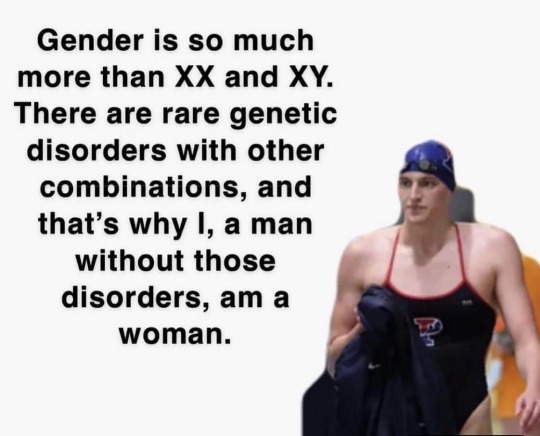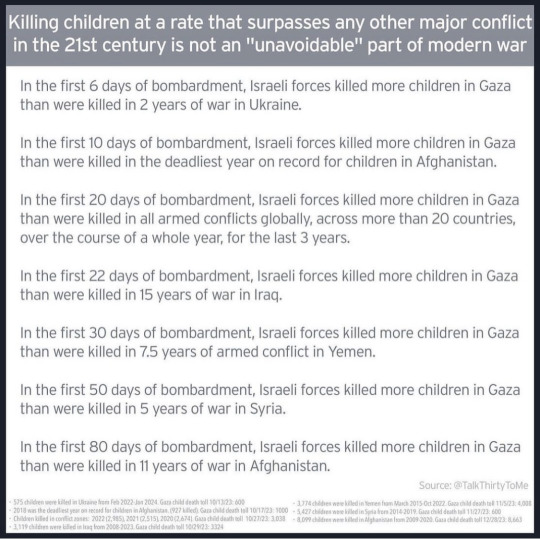Text
women artists that you should know about!!
-Judith Leyster (Dutch, 1609-1660)
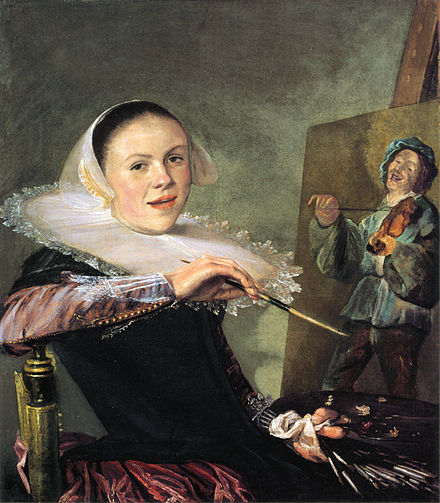
During her life her works were highly recognized, but she got forgotten after her death and rediscovered in the 19th century. In her paintings could be identified the acronym "JL", asually followed by a star, she was the first woman to be inserted in the Guild of St. Luke, the guild Haarlem's artists.
-Artemisia Gentileschi (Italian, 1593-1656)
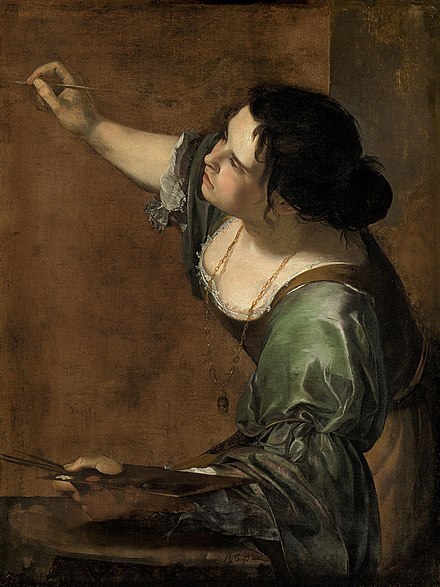
"... Si è talmente appraticata che posso osar de dire che hoggi non ci sia pare a lei, havendo fatto opere che forse i principali maestri di questa professione non arrivano al suo sapere". This is how the father Orazio talked about his nineteen year old daughter to the Medici's court in Florence.
In 1611, Artemisia got raped, and she had to Undergo a humiliating trial, just to marry so that she could "Restore one's reputation" , according to the morality of the time. Only after a few years Artemisia managed to regain her value, in Florence, in Rome, in Naples and even in England, her oldest surviving work is "Susanna and the elders".
-Elisabeth Louise Vigèe Le Brun (French, 1755-1842)

She was a potrait artists who created herself a name during the Ancien Règime, serving as the potrait painting of the Queen of France Marie Antoinette, she painted 600 portraits and 200 landscapes in the course of her life.
-Augusta Savage (Afro-American, 1892-1962)
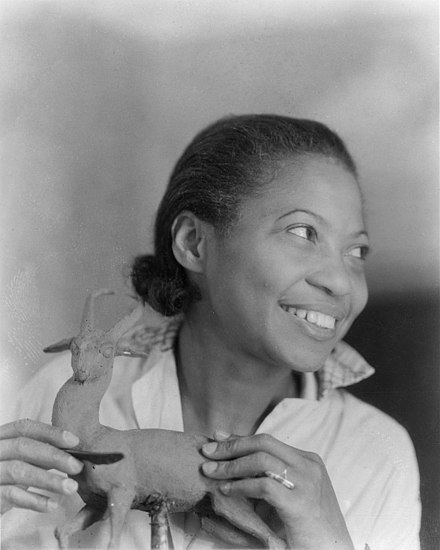
Augusta started making figures when she was a child, which most of them were small animals made out of red clay of her hometown, she kept model claying, and during 1919, at the Palm Beach County Fair, she won $25 prize and ribbon for most original exhibit. After completing her studies, Savage worked in Manhattan steam laundries to support her family along with herself. After a violent stalking made by Joe Gould that lasted for two decades, the stalker died in 1957 after getting lobotomized. In 2004, a public high school, Augusta Fells Savage Institute of Visual Arts, in Baltimore, opened.
-Marie Ellenrieder (German,1791-1863)
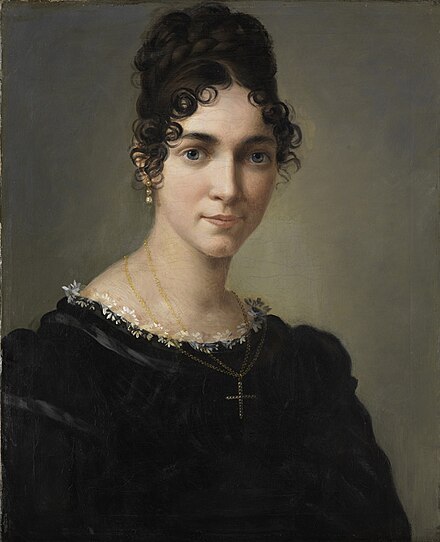
She was known for her portraits and religious paintings. During a two years long stay in Rome, she met some Nazarenes (group of early 19th century German romantic painters who wanted to revive spirituality in art),after becoming a student of Friedrich Overbeck and after being heavily influenced by a friend, she began painting religious image, getting heavily inspired by the Italian renaissance, more specifically by the artist Raphael. In 1829, she became a court painter to Grand Duchess Sophie of Baden.
-Berthe Marie Pauline Morisot (French,1841-1893)
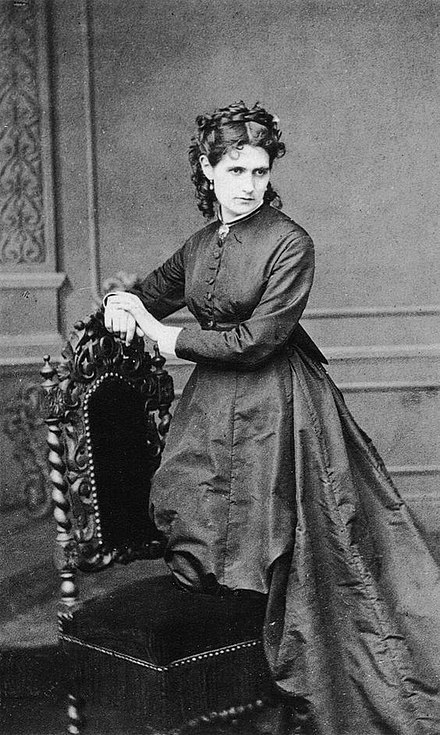
Morisot studied at the Louvre, where she met Edouard Manet, which became her friend and professor. During 1874 she participated at her first Impressionist exhibition, and in 1892 sets up her own solo exhibition.
-Edmonia Lewis or also called "wildfire" (mixed African-American and Native American 1844-1907)
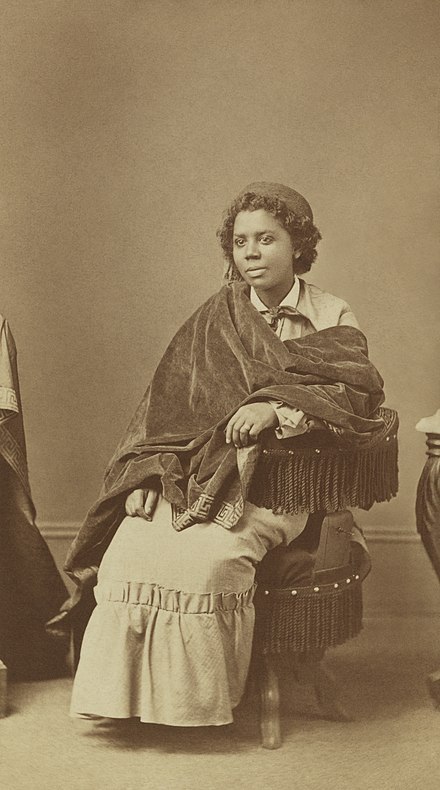
Edmonia was born in Upstate New York but she worked for most of her career in Rome, Italy. She was the first ever African American and Native American sculptor to achieve national and international fame, she began to gain prominence in the USA during the Civil Ware. She was the first black woman artist who has participated and has been recognized to any extent by the American artistic mainstream. She Also in on Molefi Kete Asante's list of 100 Greatest African Americans.
-Marie Gulliemine Benoist (French, 1768-1826)

Daughter of a civil servant, Marie was A pupil of Jaques-Louis David, whose she shared the revolutionary ideas with, painting innovative works that have caused whose revolutionary ideals he shared, painting innovative works that caused discussion. She opened a school for young girl artists, but the marriage with the banker Benoist and the political career Of the husband had slowly had effect on her artistic career, forcing her to stop painting. Her most famous work is Potrait of Madeline, which six years before slavery was abolished, so that painting became a simbol for women's emancipation and black people's rights.
-Lavinia Fontana (Italian, 1552-1614)

She is remembered for being the first woman artist to paint an altarpiece and for painting the first female nude by a woman (Minerva in the act of dressing), commissioned by Scipione Borghese.
-Elisabetta Sirani. (Italian, 1698-1665)
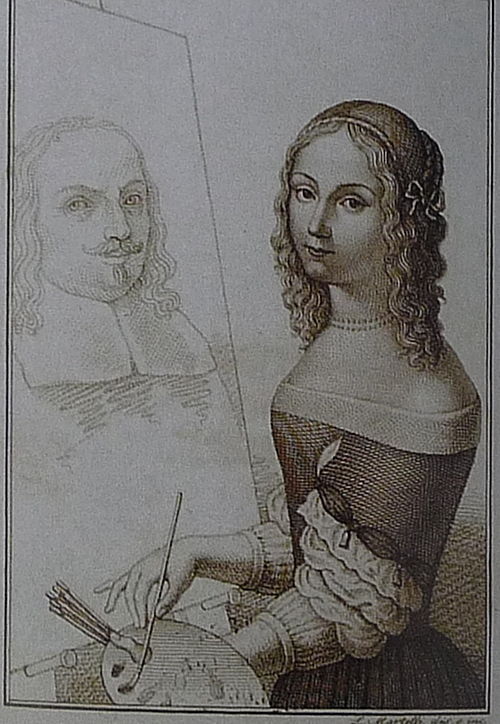
Her admirable artistic skills, that would vary from painting, drawing and engraving, permitted her, in 1660, to enter in the National Academy of S. Luca, making her work as s professor. After two years she replaced her father in his work of his Artistic workshop, turning it into an art schools for girls, becoming the first woman in Europe to have a girls' school of painting, like Artemisia Gentileschi, she represent female characters as strong and proud, mainly drawn from Greek and Roman stories. (ex. Timoclea Kills The Captain of Alexander the Great, 1659).
909 notes
·
View notes
Text
"separatism/anti-natalism is so unrealistic. it won't fix the problem." okay and marrying men worked? bearing their children worked? educating them worked? transing your gender worked? did the patriarchy stop when you wore eyeliner "sharp enough to kill a man"? did it stop when you got a mastectomy? did it come to a screeching halt when you said "sex work is work" and "not all men"? bffr
824 notes
·
View notes
Note
Sim, sim. Definitivamente tem algumas coisas que faz muito mais sentido falar em uma das línguas, até porque existem palavras que só existem no português e palavras que só existem no inglês.
Oii! você prefere falar português ou inglês? Ou depende da situação?
Bom, eu sou brasileira, então no dia a dia eu falo mais em português, exceto quando eu estou conversando com alguém que fala inglês. Porém, na internet eu falo quase exclusivamente em inglês, porque o tumblr, por exemplo, é dominado por essa língua e também pois eu cheguei ao ponto em que eu penso e consumo mais conteúdo em inglês do que português, então vem naturalmente. Mas eu não tenho problema em falar nenhum dos dois idiomas.
3 notes
·
View notes
Note
Oii! você prefere falar português ou inglês? Ou depende da situação?
Bom, eu sou brasileira, então no dia a dia eu falo mais em português, exceto quando eu estou conversando com alguém que fala inglês. Porém, na internet eu falo quase exclusivamente em inglês, porque o tumblr, por exemplo, é dominado por essa língua e também pois eu cheguei ao ponto em que eu penso e consumo mais conteúdo em inglês do que português, então vem naturalmente. Mas eu não tenho problema em falar nenhum dos dois idiomas.
3 notes
·
View notes
Text
Remember the video showing Simpson, after the ballet recital, with the Brown family—introduced by the defense to show Simpson’s pleasant demeanor. Hours later, Nicole Simpson was dead. In the video, she is as far from Simpson, physically, as she can manage. He does not nod or gesture to her. He kisses her mother, embraces and kisses her sister, and bear-hugs her father. They all reciprocate. She must have been the loneliest woman in the world. What would Nicole Simpson have had to do to be safe? Go underground, change her appearance and identity, get cash without leaving a trail, take her children and run—all within days of her call to the shelter. She would have had to end all communication with family and friends, without explanation, for years, as well as leave her home and everything familiar.
With this abuser’s wealth and power, he would have had her hunted down; a dream team of lawyers would have taken her children from her. She would have been the villain—reckless, a slut, reviled for stealing the children of a hero. If his abuse of her is of no consequence now that she’s been murdered, how irrelevant would it have been as she, resourceless, tried to make a court and the public understand that she needed to run for her life?
Nicole Simpson knew she couldn’t prevail, and she didn’t try. Instead of running, she did what the therapists said: be firm, draw a line. So she drew the sort of line they meant: he could come to the recital but not sit with her or go to dinner with her family—a line that was no defense against death. Believing he would kill her, she did what most battered women do: kept up the appearance of normality. There was no equal justice for her, no self-defense she felt entitled to. Society had already left her to die.
Andrea Dworkin, In Memory of Nicole Brown Simpson
62 notes
·
View notes
Text
In the current epidemic of rich Western women who cannot “choose” to eat, we see the continuation of an older, poorer tradition of women’s relation to food. Modern Western female dieting descends from a long history. Women have always had to eat differently from men: less and worse. In Hellenistic Rome, reports classicist Sarah B. Pomeroy, boys were rationed sixteen measures of meal to twelve measures allotted to girls. In medieval France, according to historian John Boswell, women received two thirds of the grain allocated to men. Throughout history, when there is only so much to eat, women get little, or none: A common explanation among anthropologists for female infanticide is that food shortage provokes it. According to UN publications, where hunger goes, women meet it first: In Bangladesh and Botswana, female infants die more frequently than male, and girls are more often malnourished, because they are given smaller portions. In Turkey, India, Pakistan, North Africa, and the Middle East, men get the lion’s share of what food there is, regardless of women’s caloric needs. “It is not the caloric value of work which is represented in the patterns of food consumption” of men in relation to women in North Africa, “nor is it a question of physiological needs…. Rather these patterns tend to guarantee priority rights to the ‘important’ members of society, that is, adult men.” In Morocco, if women are guests, “they will swear they have eaten already” or that they are not hungry. “Small girls soon learn to offer their share to visitors, to refuse meat and deny hunger.” A North African woman described by anthropologist Vanessa Mahler assured her fellow diners that “she preferred bones to meat.” Men, however, Mahler reports, “are supposed to be exempt from facing scarcity which is shared out among women and children.”
“Third World countries provide examples of undernourished female and well-nourished male children, where what food there is goes to the boys of the family,” a UN report testifies. Two thirds of women in Asia, half of all women in Africa, and a sixth of Latin American women are anemic—through lack of food. Fifty percent more Nepali women than men go blind from lack of food. Cross-culturally, men receive hot meals, more protein, and the first helpings of a dish, while women eat the cooling leftovers, often having to use deceit and cunning to get enough to eat. “Moreover, what food they do receive is consistently less nutritious.”
This pattern is not restricted to the Third World: Most Western women alive today can recall versions of it at their mothers’ or grandmothers’ table: British miners’ wives eating the grease-soaked bread left over after their husbands had eaten the meat; Italian and Jewish wives taking the part of the bird no one else would want.
These patterns of behavior are standard in the affluent West today, perpetuated by the culture of female caloric self-deprivation. A generation ago, the justification for this traditional apportioning shifted: Women still went without, ate leftovers, hoarded food, used deceit to get it—but blamed themselves. Our mothers still exiled themselves from the family circle that was eating cake with silver cutlery off Wedgwood china, and we would come upon them in the kitchen, furtively devouring the remains. The traditional pattern was cloaked in modern shame, but otherwise changed little. Weight control became its rationale once natural inferiority went out of fashion.
— Naomi Wolf (1990) The Beauty Myth
732 notes
·
View notes
Text
“It’s not that men can’t be wrecked. There are plenty of male celebrities who have become the targets of full-scale, cross-culture hatred. But they usually have to work a lot harder for it: Chris Brown had to beat his girlfriend within an inch of her life. Justin Bieber and Michael Richards had to get caught dropping n-bombs. Mel Gibson had to terrorize his girlfriend, and also utter every ethnic and sexist slur in the books, on more than one occasion, over a period of years, before we gave him up. Conversely, just try asking people why they “hate” Katherine Heigl, or Kristen Stewart, or Anne Hathaway: She just seems arrogant. She just seems unpleasant. She just seems like she’s trying too hard to be liked. Men also have more options, in terms of redeeming themselves. It’s easy to say that acts of open violence are the line to draw, but if you can even remember that the rugged-yet-sensitive heartthrob Josh Brolin was arrested on a domestic battery charge in 2004, you’re a rare bird indeed. Bringing up the fact that Norman Mailer stabbed his wife will get you labeled a philistine, in some circles. Steven Tyler once adopted a sixteen-year-old girl in order to have sex with her, and for his crimes, we rewarded him with a judge slot on American Idol. And, while I could try to find examples of famous men who have redeemed their reputations from wild behavior, promiscuous sex, and irresponsible drug use, research reveals that the answer is, roughly, all of them. In fact “redemption” seems like the wrong word for what happens to some of these guys: Keith Richards’s drug career has included accidentally snorting strychnine, setting himself on fire on multiple occasions because he was so wasted he passed out while smoking a cigarette, and taking to the media in 2013 to defend heroin as essentially useful to the creative process. Hunter S. Thompson was best known for getting wasted on the job and living in a “fortified compound” stocked with dynamite and heavy firearms. Henry Miller wrote a modernist epic about how much fun it was to have sex with prostitutes. Members of Led Zeppelin once encouraged a woman to put a dead fish up her vagina. For all this, these guys became heroes: hard-living, boundary-pushing rock-and-roll badasses. Courtney Love and Lindsay Lohan, though? Those bitches are crazy.”
— Trainwreck: The Women We Love to Hate, Mock, And Fear And Why, Sady Doyle
2K notes
·
View notes
Text


“The women leaders in our study were considered too young or too old. They were too short or too tall, too pretty or too unattractive or too heavy. They had too much education or not enough or their degrees were not from the “right” schools. They suffered from disrespect and misperceptions due to race, color, or ethnicity. Whether they had children or were childless, the women were expected to work harder than men to prove their worth. Women were held back from leadership opportunities due to being single, married, or divorced. There was no personality trait sweet spot, as introverted women were not seen as leaders and extraverted women were viewed as aggressive. The effect, then, means women leaders are “never quite right.””
Full text under cut
https://www.fastcompany.com/90889985/new-research-reveals-critiques-holding-women-back-from-leadership-that-most-men-will-never-hear
A recent study of the 33 biggest multilateral institutions found that of 382 leaders in their history only 47 have been women. And the percentage of women running Fortune 500 companies has only just recently crested a meager 10%.
As researchers we wondered why institutions consistently fail to promote women to top jobs. Our recent study of 913 women leaders from four female-dominated industries in the U.S. (higher education, faith-based nonprofits, law, and healthcare) sheds light on this pernicious problem. As we found, there’s always a reason why women are “never quite right” for leadership roles.
Women are criticized so often and on so many things that they are acculturated to receiving such disparagement, taking it seriously, and working to make improvements. And any individual woman may take it personally, believing the criticism directed at her to be warranted.
But our research reveals that the problem lies elsewhere. Virtually any characteristic can be leveraged against a woman in a discriminatory fashion. Such criticisms often relate to facets of women’s identity in an overt or subtle way, such as race, age, parental status, attractiveness, and physical ability.
Effectively, the surface-level critique functions as a “red herring,” distracting from the inherent gender bias driving the encounter. This type of treatment is so common that we have called it “we want what you aren’t” discrimination.
More specifically, our research revealed 30 different characteristics and qualities of a woman’s identity that emerged as points of criticism creating barriers to women’s success. The clear message to women is that—whatever they are—they are “never quite right.”
Age was a consistent challenge for women leaders in our study. Some of our respondents reported being considered too young to lead, while others indicated being too old hindered them from advancing.
However, being middle-aged didn’t help women’s career prospects either. A physician shared: “I am middle-aged, and men my age are seen as mature leaders and women my age as old.”
Parental status—having children or being childless—emerged as another point of criticism. A higher-education leader described how people assume she “can’t take on a bigger role ‘because of the kids,’” which made her feel that she needed “to work extra hard” to show that she could be both a dedicated mother and a leader.
On the other hand, a childless physician was expected to “work harder/more, accomplish more” than other female colleagues. Mothers were also bypassed for career opportunities, as happened to a single divorced lawyer who was the mother of preschoolers, “due to a perception by my male bosses that I cannot or should not handle [larger matters].”
Likewise, pregnancy was problematic, particularly for lawyers in our study. There was doubt that women would come back to work after maternity leave. Some were no longer given good assignments, while others were forced to quit private practice or work part time. One lawyer described the loss of confidence from bosses:
“Once you are pregnant or trying to have kids, the way management views you deteriorates. The opposite thing happens for male coworkers. I’ve seen it in so many law firms it’s impossible to argue it was just coincidence or based on merit.”
Simply planning on having kids was enough to invoke bias. A woman in higher education reported being denied promotion because she would need maternity leave for hypothetical future children.
Women of color were targets of subtle bias. An African American faith-based leader described being “invisible” and regularly “talked over” by white men. A Native American higher-education executive described being misperceived as weak, “when in fact we are practicing ‘respect’ for ourselves and others.” And a Filipina physician described facing role incredulity, as people assumed that she was “a nurse, and not a doctor and a division chief at that.”
Even physical ability and health played into the women’s experiences. Physical disabilities led to assumptions of not being capable. One higher-education leader who uses a crutch was questioned by men about the way she walks and has been told “to hide my cane, especially for photographs,” as she said.
Regarding health, there were double standards around the way men and women with illnesses were treated. A physician developed ovarian cancer while serving as an officer in the public health service. She explained, “The plan was to discharge me . . . even though men with prostate cancer didn’t have to go through that.”
The women leaders in our study were considered too young or too old. They were too short or too tall, too pretty or too unattractive or too heavy. They had too much education or not enough or their degrees were not from the “right” schools. They suffered from disrespect and misperceptions due to race, color, or ethnicity. Whether they had children or were childless, the women were expected to work harder than men to prove their worth. Women were held back from leadership opportunities due to being single, married, or divorced. There was no personality trait sweet spot, as introverted women were not seen as leaders and extraverted women were viewed as aggressive. The effect, then, means women leaders are “never quite right.”
Organizations that fail to promote and support women in their top roles miss out on performance gains. Fortunately, there are concrete steps that organizational leaders, allies, and individual women can take to mitigate this “never quite right” bias, aiding women’s workplace advancement.
“Flip it to test it”
Leaders can be particularly effective in thwarting sexist criticisms toward women. It’s not about changing the behavior of women—who are the recipients of the unfair treatment—but it is about changing the behaviors of those who justify their actions as somehow merited. Many criticisms fail the “flip it to test it” method miserably. Ask yourself, would the following statements ever be said about a man?
He needs to smile more.
Men are going to have kids and not want to work.
Since Larry has prostate cancer, he can no longer fulfill his job duties.
The clear answer is no. Leaders can infuse awareness of this simple, yet effective, tool to reduce such bias-laden criticisms. And workplace allies can help stop unfair criticism of women by calling it out.
Constructive career-enhancing feedback
Women are almost one and a half times more likely to receive negative feedback that is subjective rather than constructive and objective feedback. Men are often given a clearer idea of where they excel and opportunities for improvement whereas women are given vague feedback that often focuses on qualities like communication style. Even when using formal performance evaluation rubrics, a disparity remains.
Developmental feedback to women focuses on operational tasks, coping with politics, developing resilience, being cooperative, and building confidence. Developmental feedback to men focuses on setting a vision, leveraging power and politics, being assertive, and displaying confidence. Leaders can reduce the gender-biased framing by encouraging all employees to develop both sets of skills.
Do not take it personally
For individual women, hear us when we say, “It’s not you.” We women are conditioned to accept feedback and internalize it as something to “fix” about ourselves. If you are criticized, consider whether it is objective, constructive, and warranted. Disregard identity-based criticisms that are part of a larger pattern of bias against women.
Our research demonstrates that practically any characteristic can be proclaimed problematic for a woman leader to question her competence and suitability for leadership. It takes deliberate effort, but we can turn the message to women from “We want what you aren’t” into “We want what you are.” Doing so will advance women in the workplace and profit the entire organization.
Amy Diehl, PhD, is chief information officer at Wilson College and a gender equity researcher, speaker, and consultant. She is coauthor of Glass Walls: Shattering the Six Gender Bias Barriers Still Holding Women Back at Work.
Leanne M. Dzubinski, PhD, is acting dean of the Cook School of Intercultural Studies and associate professor of intercultural education at Biola University, and a prominent researcher on women in leadership. She is coauthor of Glass Walls: Shattering the Six Gender Bias Barriers Still Holding Women Back at Work.
Amber L. Stephenson, PhD, is an associate professor of management and director of healthcare management programs in the David D. Reh School of Business at Clarkson University. Her research focuses on how professional identity influences attitudes and behaviors and how women leaders experience gender bias.
1K notes
·
View notes
Text

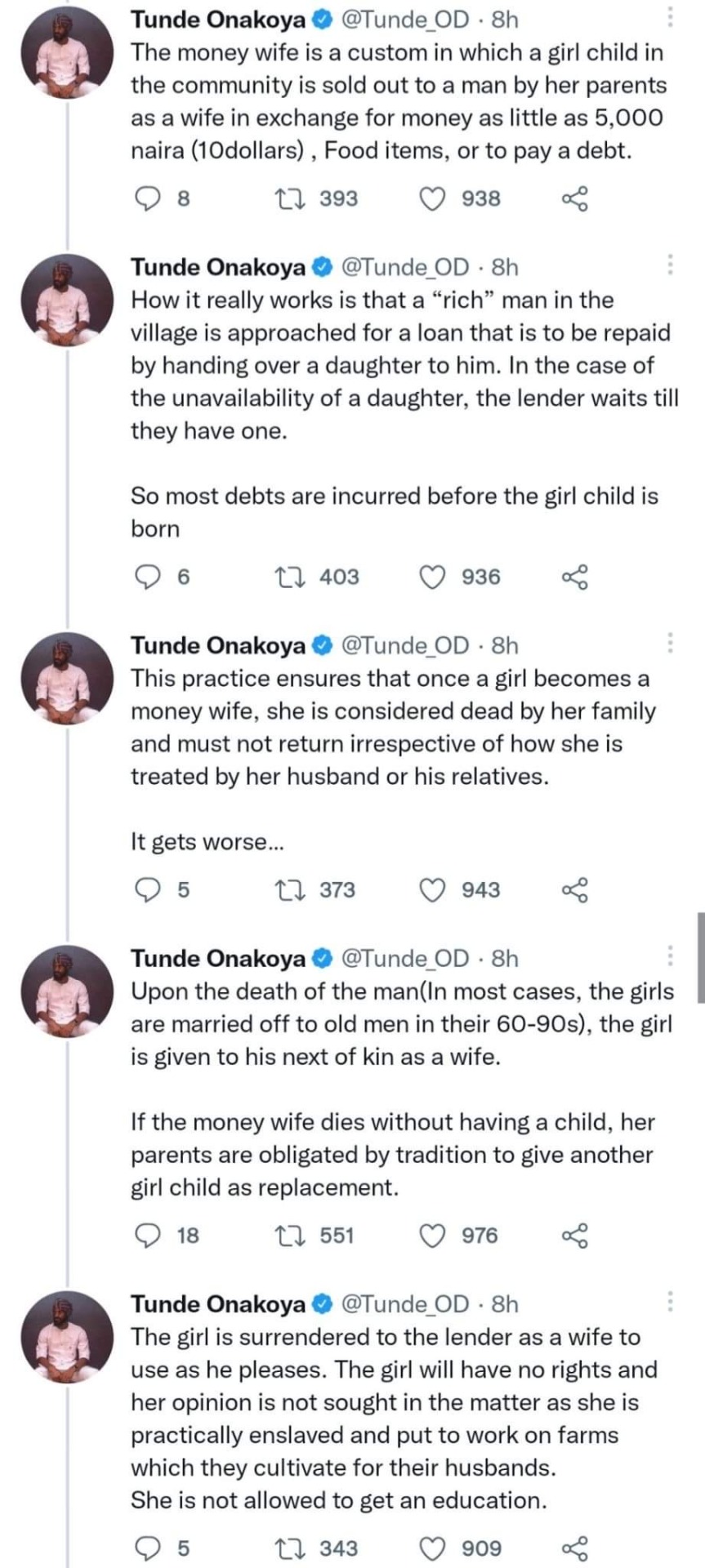
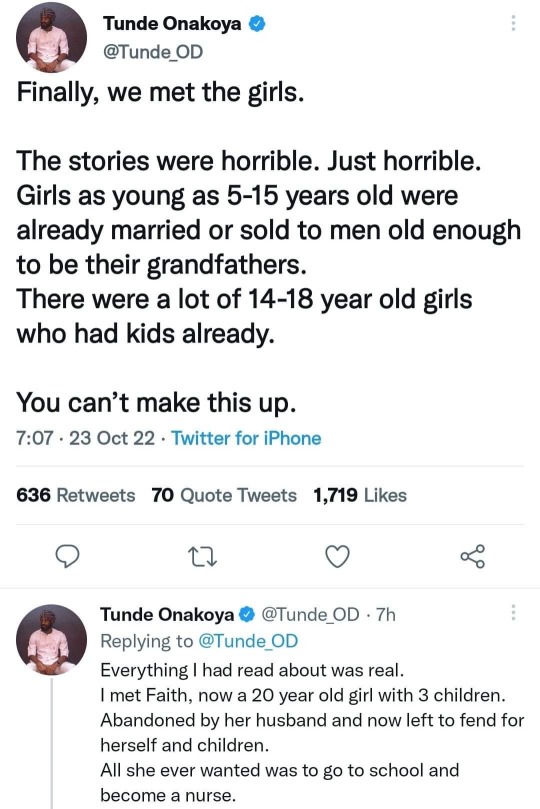



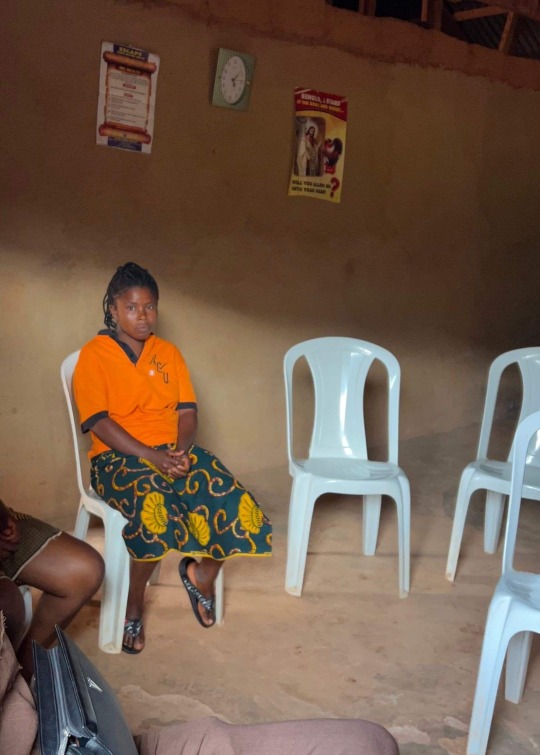

(x) “Money wives” aka culturally accepted sexual slavery of girls as young as 5-14 years in Cross Rivers State, Nigeria
2K notes
·
View notes
Text
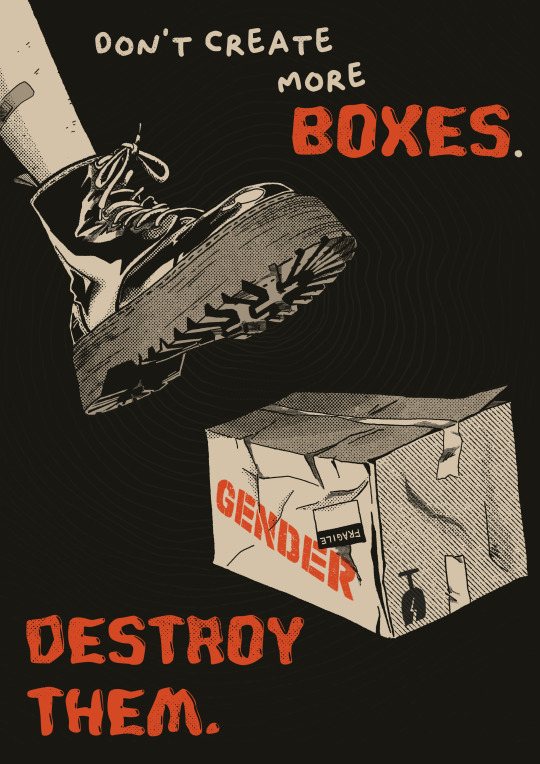
When I was a little girl, I thought I should've been a boy. I didn't fit in with the other girls I knew and I didn't fit in with what I was told a girl was supposed to be like.
Eventually, when I was 10 or so, I started thinking that I was a girl because I had the body of a girl. And as such, the other things people told me were clearly unnecessary to be a girl - they were all made up BS.
That line of thought helped me with accepting myself for a very long time. But back then, I only knew of mainstream feminism, and as it's narrative quickly began to change around gender, I found myself trying to reconcile that old thinking with this new one about identification.
I didn't want to be hateful or anything. I knew after all, how bad it was to feel like you couldn't be yourself due to your gender. But that old lightbulb moment I had as a kid, it stuck with me.
I'd talk to an enby friend who explained it to me like, "I am nonbinary because I like feminine and masculine things", and all I could think was, "that is the most misogynistic thing I have ever heard". I'd read trans people talk about how stereotypes were good, actually. I saw a kids book about how a tomboy girl was actually a boy. All of that, while they still claimed that gender roles were bad.
It was like I was going crazy.
When I found radical feminism, and they viewed things in that same way, it was freeing. I didn't feel like I was doublethinking no more.
I want to destroy gender roles, destroy gender itself. That doesn't mean biological sex will vanish. But the rest, the other "made up bullshit", it must go.
(also I used my own boots to make this picture. It's one of my favorites I have made so far)
#sharing because I had basically the same experience#I was the poster kid for transgenderism as a child#if i had a liberal family i would have been transed in a second#i wanted a double mastectomy#i literally truly believe that my internal organs were male and i was actually just a girl on the exterior#i would stand in front of the mirror trying to see if i could ever look like a boy and train my voice to be deeper#all of that and more#and i was already very justice based and feminist as child even tho my parents were very badly religious#so it was a big surprise to me when i got my period at eleven#and after that i was forced to accept that i was fully a girl#at first it was scary and i hid it from everyone but then#it became so freeing#i already knew it was bad to force girls to wear and like feminine things from my sense of fairness and justice#but knowing that there wasnt anything different or wrong with me especifically for not being any of those things#i was just a girl like all others#it was really liberating#an eureka moment for real#so i don't think i would ever be truly able to accept the transgenderism movement with all of its misogyny#i just can't go backwards#i can't learn something so essential and then unlearn it#it would be equal to getting dumber#and also more ignorant#and that just won't do
2K notes
·
View notes
Text
On this year women's day, all we could think about are Palestinian women in Gaza.

Nearly 9,000 women have been killed in Israeli attacks in five months. Another 2,100 are missing and presumed dead, while 23,000 have been wounded and over half a million are displaced.
“Palestinian women, especially in the Gaza Strip, are exposed to the worst humanitarian catastrophe,” Ashraf al-Qudra, the health ministry’s spokesperson, said on Thursday.
Dozens of women and girls have also been detained and face harsh conditions in Israeli custody, including sexual abuse.
Women in Gaza also struggle to find menstruation products and access the necessary pregnancy and post-natal care. The consequences on reproductive health, including a rise in stress-induced miscarriages, stillbirths and premature births, have increased significantly.
Women in labour are undergoing caesarean procedures without anaesthetics, and a shortage of post-operative care such as medication, antibiotics and pain relief further exacerbates the situation.
According to the health ministry, 5,000 women give birth monthly in Gaza under “harsh, unsafe and unhealthy” conditions caused by Israeli bombing and displacement.
There are 60,000 pregnant women in Gaza suffering from “malnutrition, dehydration and lack of medical care.
There have also been repeated cases of Israeli soldiers mocking Palestinian women by posting videos and pictures of themselves rummaging through personal belongings in Gaza homes, making derogatory comments and posing with women’s underwear.
32K notes
·
View notes
Text
False rape accusations are an anomaly.
True rape accusations are a norm.
You’re, quite literally, more likely to be killed by a comet than falsely accused of rape.
298K notes
·
View notes
Text
Dismantling the Lies of Abusive Parents Masterlist
Resources
Giving you food and clothing is the bare minimum
You don’t owe gratitude for food and clothes you needed as a child
You had the right for basic resources
Parents shaming you for costing money is ironic and stupid
What it means when they say ‘This is MY house’
My house = my rules is blackmail
Children don’t owe absolute obedience for being fed and sheltered
Physical abuse
You are allowed to refuse any touch, not only violence
If they ‘don’t know they’re hurting you’, why do they ignore or punish you when you protest?
Hitting children is irrational and doesn’t work
You cannot ‘provoke’ your parents to abuse you if they’re not abusive
Why do parents hit, manipulate and traumatize children
Blatant Lies
Care, nurture and affection do not make you weak
They’re lying when they say it ‘wasn’t that bad’‘
You wouldn’t have grown up spoiled if not for abuse
You got too affected by it’ is a lie
Your parents are not ‘just too emotionally immature’ to understand abuse
‘You’re not living in the real world!’ is nonsense
You’re not worthless, a burden, ungrateful, or stupid, and your parents know that.
Constant undermining of your accomplishments is abuse
Not being allowed to talk about the past is symptom of abuse
Parents who want you to be happy vs look happy
You are not abusive for resisting abuse
When they claim ‘they didn’t mean it’, it’s still abuse
Your parents are responsible for their own actions regardless of how badly they try to shift blame on you
Psychological abuse
Blind Obedience is not required in a healthy upbringing
Disgust is a weapon abusive parents use on their kids
If they say they love you, but walk all over your feelings, they don’t
Parents don’t have the right to enter your room to scream at you
Parents insisting for you to be ‘tough’ are doing it to hide the trauma
Even if a kid acts like ‘they can take it’, it’s still abuse
Pretending abuse is discipline will leave children permanently scarred
It’s inhumane to control and shame children’s reactions to abuse
Why don’t you already know this? vs Teaching you necessary skills
Acting like they’ll change is escape sabotage
Parents are responsible for protecting children from harm
References to how healthy parenting looks like
Not being allowed to be angry with your parents is psychological abuse
If parents want you to act the way you did when you were little, they’re dangerous
Threats about how hard your life will be later on, are bad for you
Lack of continuity and ever-changing rules will cause anxiety
Forced obedience will lead you to abusive relationships
Parents acting like you’re a ‘bad child’ is a shame tactic to control you
There’s healthy and abusive ways to give children chores
Revisioning the past and insisting you remember it wrong is gaslighting
If your parents make you suicidal, they’re abusive
Parents threatening ‘they could be worse’ is abuse
Always assuming the worst intentions for your actions is wrong
Keeping children hostage in abuse is torture
If this hits home, also read Recognizing Abuse Masterlist
31K notes
·
View notes

